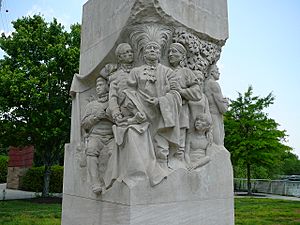Treaty of Holston facts for kids
The Treaty of Holston was an important agreement signed between the United States government and the Cherokee people. It was signed on July 2, 1791, and officially announced on February 7, 1792.
William Blount, who was the governor of the Southwest Territory, worked with leaders from the Cherokee nation, like John Watts, to create this treaty. The treaty set up how the United States and the Cherokee would get along. It also said that the Cherokee tribes would be under the protection of the United States. This meant the U.S. would handle all future dealings with other countries for the Cherokee tribes.
Today, you can find a monument to this treaty in downtown Knoxville, Tennessee. It was put there in 1997, right by the Tennessee River, where the treaty was first discussed.
What Was Agreed in the Treaty?
The Treaty of Holston included several key points to create peace and set rules between the United States and the Cherokee.
Main Points of the Agreement
Here are some of the most important things the treaty said:
- Peace and Friendship: Both sides agreed to have lasting peace and friendship.
- U.S. Protection: The Cherokee agreed to be under the protection of the United States.
- Returning Captives: Any prisoners held by either side had to be returned.
- Clear Borders: The treaty drew clear lines to show where Cherokee lands ended and U.S. lands began.
- Roads and Trade: The United States was allowed to build a road. The U.S. would also control trade with the Cherokee.
- Cherokee Land Rights: The U.S. promised that the Cherokee lands had not been given away to the United States.
- No Settlers on Cherokee Land: U.S. citizens were not allowed to live on Cherokee lands. If they did, the Cherokee could punish them.
- No Hunting on Cherokee Land: U.S. citizens were also not allowed to hunt on Cherokee lands.
- Dealing with Criminals: The Cherokee had to hand over criminals to the United States. Also, U.S. citizens who committed crimes on Cherokee land would be punished.
- Stopping Revenge: Both sides agreed to stop taking revenge on each other.
- Warning of Attacks: The Cherokee agreed to tell the United States if other tribes were planning attacks against them.
- Helping Farmers: The United States agreed to give gifts to the Cherokee. This was to encourage them to start farming more.
- Ending Bad Feelings: Both the U.S. and the Cherokee agreed to stop any bad feelings they had toward each other.
Changes to the Treaty
Later, on February 17, 1792, an extra part was added to the treaty. This part was signed by Henry Knox, who was the Secretary of War for the U.S., and Cherokee representatives. This addition increased the yearly payments, called annuities, that the United States would give to the Cherokee leaders.
The Cherokee leaders had asked for a few things, which included:
- They wanted more money each year for the lands they had given up in the original treaty.
- They wanted white settlers who were living south of a certain ridge to move away.
- They asked for a respected person from the U.S. government to live with them. This person would be their advisor and protector.
- They wanted to stop a planned settlement by a company near the Muscle Shoals area.
- They also wanted the yearly goods, like plows and other farming tools, that were mentioned in the treaty.
- Finally, they suggested that certain people, like John Thompson and James Carey, be appointed as interpreters.


